6+ Sample Feasibility Study Outline
-

Feasibility Study Outline Template
download now -
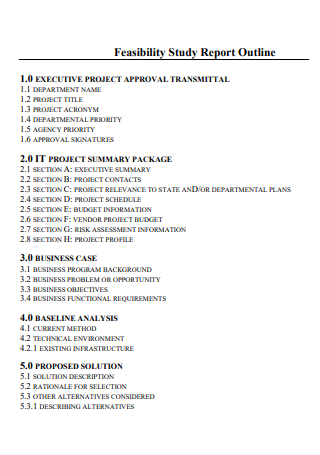
Feasibility Study Report Outline
download now -
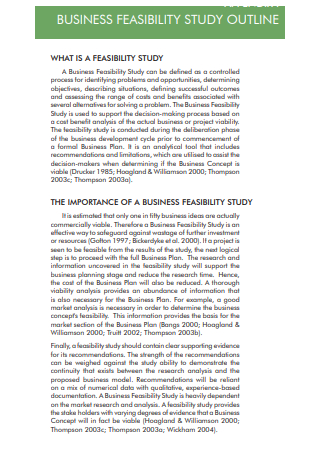
Business Feasibility Study Outline
download now -
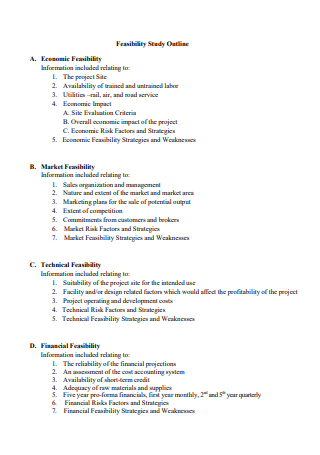
Feasibility Study Outline Example
download now -
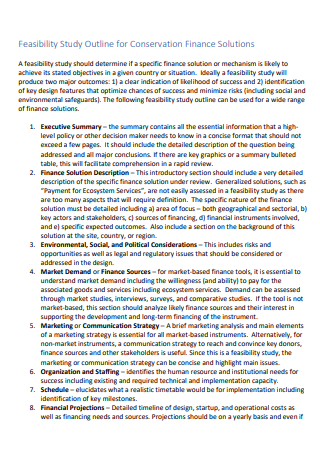
Finance Solutions Feasibility Study Outline
download now -
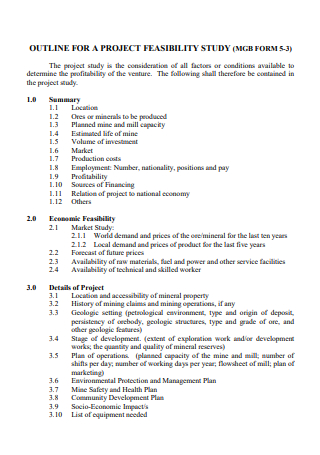
Project Feasibility Study Outline
download now -

Pre-Feasibility Study Outline
download now
FREE Feasibility Study Outline s to Download
6+ Sample Feasibility Study Outline
What Is a Feasibility Study?
Benefits of Feasibility Study
Elements of a Feasibility Study
Components of a Feasibility Study
How to Conduct a Feasibility Study
FAQs
How do you know if a project is feasible?
How long should a feasibility study be?
What is the first step in a feasibility analysis?
What Is a Feasibility Study?
A feasibility study evaluates whether a proposed project, such as a new product line or technical system, would succeed. The research studies the project’s essential variables, including technical, economic, and legal issues, to determine whether the project merits an investment. Also, the analysis can highlight prospective concerns and problems due to pursuing the project. Moreover, feasibility studies assist businesses with new company growth, such as establishing how the firm will work, potential impediments, competition, market analysis, and the amount and source of capital required to expand the business. They can assist in developing marketing tactics to persuade investors and banks that investing in a specific project or business is prudent. Once the feasibility study is complete, stakeholders should have a clear understanding of all aspects of the project and be able to decide whether to proceed. A manufacturer may examine a feasibility study to see whether a facility expansion will increase income.
Benefits of Feasibility Study
Completing a project’s feasibility study is a crucial stage that can aid project managers in deciding whether or not to invest time and money in the venture. Feasibility studies may also prevent a company’s management from undertaking risky business ventures by presenting crucial information. A further advantage of conducting a feasibility study is that it facilitates the creation of new initiatives by offering information on variables such as how a company will operate, what challenges it may face, who its rivals are, and how much and where it will obtain finance. These marketing strategies are the objective of feasibility studies, which attempt to persuade bankers and banks that investing in a specific business idea is sensible.
Elements of a Feasibility Study
When contemplating the launch of a new initiative, feasibility studies are of the utmost importance. Management or directors of a company may perform a feasibility study or assign the process to senior managers if they need more expertise or time to conduct the analysis themselves. You may include the following components if you intend to perform a feasibility study:
Components of a Feasibility Study
A feasibility study collects crucial company data and urges investors, company leaders, and other personnel to support a project. Consider including the following components of a feasibility study in your own:
1. Title Page and Table of Contents
The title page is the initial section of the feasibility study that the reader encounters. You should select a title that is concise and informative about your project. Your title page should also include the names and work titles of the project manager and team members. Include the project’s anticipated start and finish dates to provide further context for the reader’s understanding of your time frame. In addition, the table of contents attempts to facilitate the reader’s access to any section of the report. After completing the information, complete the table of contents to ensure that the page numbers correspond with the section headings. Typically, your word processor includes a table of contents feature, making creating this component quick and easy.
2. Executive summary and Market Feasibility
Your feasibility study should begin with the executive summary as its primary component. This section should contain an introduction to the project, its objective, the targeted solutions, and an overview of the sources used to establish the report’s credibility. In addition, the market feasibility section of your study contains analytical information about business data, market research reports, and the organization’s future outlook. Start with an overview of your company’s industry. Describe the industry’s history, current practices, trends, and future estimates. Then, you might refine your focus to highlight your company’s position inside the industry. Identify your key competitors, primary revenue sources, sales numbers, and prospective niche markets you could pursue to increase your customer base. The market feasibility section gives the reader a deeper insight into your organization, its offerings, and how the feasibility project could contribute to its growth.
3. Technical feasibility
In the section on technical feasibility, you list several operational factors that affect how well your business does. Talk about where your business is, what materials are needed to make the products or services you offer, how they are made, how quality is checked, and what transportation is required to get your products to stores. In the technical feasibility section, you tell your reader in detail what keeps your business going so you can keep giving your customers the best products and services. This section also adds to the credibility of your section on financial feasibility.
4. Financial feasibility
The financial feasibility section describes to the reader all facets of your company’s finances. Provide information about your investors, current revenue, assets, liabilities, and the prior year’s total yearly revenue in this area. Provide a cost-benefit analysis that supports your organization’s requirements. The financial feasibility section aims to persuade readers to invest their support, cash, or both in the proposed project by demonstrating the operational expenses.
5. Organizational feasibility
The organizational feasibility part demonstrates your organization’s legal and ethical policies to the reader. This section should outline your company’s organizational structure, including branch locations and departments. You may wish to include a brief biography of each of your company’s founders or board members. You can also profit from emphasizing the HR procedures your company does to preserve ethical and legal responsibilities for its employees and the motivational techniques you implement to increase workplace efficiency. The organizational feasibility section assists the reader in determining if your organization’s current practices complement or support the planned endeavor.
6. Conclusion and Appendix and Reference Pages
Your report’s conclusion is the final written portion before the appendix and reference pages. This section provides a summary of all previous areas. You should conclude the paper by emphasizing one or more recommendations to encourage further action. If these suggestions require more than a few sentences of explanation, create a separate section for them. In addition, an appendix is an optional section, but it is typically valuable to the report’s reader. This part contains any material that the reader may find beneficial but is not immediately related to the other issues mentioned in the report. You should provide references regardless of whether you include an appendix section. A reference section may span one or more pages depending on the sources utilized to compile the report. You may utilize company records, scholarly articles about your industry, and any other materials you authored throughout the project’s execution. Use citations that comply with the style manual you are employing.
How to Conduct a Feasibility Study
Consider the most recent occasion you had to solve a problem at home or work. If it was a problem you had encountered before, you probably had prior experience or a game plan to guide your actions. However, new issues or circumstances necessitate innovative thinking methods and solutions. When deciding how to approach a business need, problem, or opportunity, it is essential to assess the viability of your strategy and the necessary steps for success. But how do you distinguish a feasible endeavor from one that is misguided? Here are five steps to ascertain the viability of your project:
1. Analyze the Issue
First, assess the practicability and viability of the proposed plan by conducting a preliminary analysis of project requirements. Do you have the necessary technology and resources to launch the project? How will you evaluate and determine the project’s return on investment? Understanding your business’s goals and objectives before initiating the project will aid in keeping everyone on the same page and operating toward the same purpose.
2. Assess the Budget
Budget mismanagement or waste is the quickest method to derail a new project or endeavor. Especially when budgets are constrained, your stakeholders will want to know if the money you spend will affect the bottom line. Determine the available funding for the undertaking and identify the anticipated revenue streams. How will this endeavor generate a financial return on investment?
3. Do Your Research
Next, delve deeply into the market. Exists a market for your product or business strategy? For smaller undertakings, what roadblocks can you anticipate? What actions do your competitors take? If your project objectives are too confined or do not align with larger business objectives, consider reconsidering your approach.
4. Make a Plan
Create an action plan to bring your endeavor to life using your research. What personnel, processes, and technologies will be required to complete the project? This plan can be constructed using a work breakdown structure (WBS), which divides projects into smaller, more manageable tasks that can be evaluated and reasonably assigned to teams. There are numerous diagrams available for improved project management plans.
5. Decide What’s Next
With these assessments, you can confidently, objectively, and strategically determine whether the endeavor is feasible. You can develop a more strategic plan through a feasibility study if needed. If all indications point to “yes,” it is time to proceed with your undertaking. Many businesses are tempted to skip evaluation stages to complete projects more rapidly due to the rapid pace of business. Too frequently, however, this results in misalignment, derailed projects, duplication of effort, or even worse, time and money squandered. Regardless of your industry, a feasibility study can help you identify risks and uncertainties and boost your business’s chances of success.
FAQs
How do you know if a project is feasible?
A feasibility study evaluates all aspects of your project, including the availability of time and capacity, financial and other resources, market demand, and technical aspects, so you can decide whether or not to move forward with your project concept.
How long should a feasibility study be?
A feasibility study will take four to five months to complete. Due to the more significant number of interviewees and additional methods, such as focus groups and online surveys, the college level will require almost five months.
What is the first step in a feasibility analysis?
Start by outlining your plan. Second, evaluate your plan’s potential market and commercial viability. Third, assess the plan’s strengths and weaknesses. Determine whether there are any hazards.
An outline of a feasibility study will help you avoid the squandering time, money, and effort on a business that is not viable from the start. It is required if you intend to establish a business. You can create a feasibility study outline independently, but hiring an expert in your industry is preferable. Are you ready to make your feasibility study summarize? Check some templates above and create yours now!
